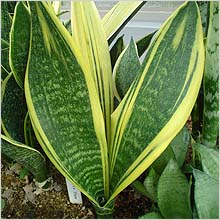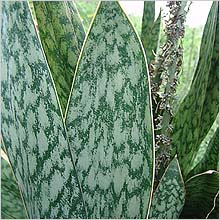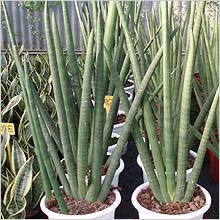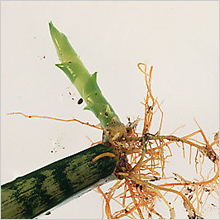How to Grow and Care for Snake Plant
Snake plant, also called mother-in-law's tongue, Saint George's sword, or snake skin is a popular and hardy houseplant with stiff, sword-like leaves. It's available in different varieties, many of which have green-banded or striped leaves with a yellow or cream border.
This attractive, easy-to-grow houseplant tolerates drought and low light, making it the go-to option for spaces like offices.

Botanical name snake plant - Dracaena trifasciata (Sansevieria trifasciata). It is a species of flowering plant in the family Asparagaceae, native to tropical West Africa from Nigeria east to the Congo. Until 2017, it was known under the synonym Sansevieria trifasciata.
Not long ago, based on the results of genetic research, the independent genus Sansevieria was completely excluded from botanical classification, and all species were classified under the genus Dracaena. As of July 26, 2022, the WFO database lists the genus Sansevieria as synonymous with the genus Dracaena. The species name Sansevieria trifasciata is synonymous with the name Dracaena trifasciata.
The plant's native habitat is Asia and the Congo River basin in Africa. It has been known in Europe since the 18th century.
It is an evergreen perennial plant forming dense strands, spreading by way of its creeping rhizome, which is sometimes above ground, sometimes underground. Its stiff leaves grow vertically from a basal rosette.

As a houseplant, only about ten species of Sansevieria are grown, and almost all of them are popular mainly due to their unpretentious nature. Sansevieria trifasciata (Dracaena trifasciata) is the most popular species, a perennial evergreen plant with long, upright leaves growing directly from the rhizome upwards.
The leaves are dark green with light vertical or transverse stripes depending on the species. The length of the leaf can be up to 1 meter. Snake Plant is distinguished by its excellent decorative qualities and has long been used for greening apartments and offices.
With sufficient light, Mother-in-law's Tongue can bloom even in indoor conditions. The flower stalk appears in spring from the rosette of leaves, with small white flowers that are highly aromatic, reminiscent of the scent of vanilla.


Each rosette of Sansevieria produces only one flower stalk, and after flowering, no new leaves grow from that rosette.
It is known that Snake Plant purifies the air in the apartment, neutralizes harmful substances, destroys bacteria, and also boosts the immunity of the inhabitants of the apartment.
The plant can be recommended for a child's room, but it should be noted that some species of Sansevieria contain sap that does not cause skin irritation but can induce nausea if ingested. Therefore, if the children are still small and tend to put everything in their mouths, place the plant in an inaccessible location.
Care for Snake Plant (Dracaena trifasciata)
Mother-in-law's Tongue is an undemanding plant, easily tolerating drafts, soil dryness, and requiring no special care or difficulties in propagation. It is suitable even for novice gardeners.
Light: Illumination plays no special role; it grows well in bright light and in the shade. Variegated species in the shade may lose their bright color. In summer, Snake Plant is taken out to the balcony but placed so that it does not get wet in the rain.
Temperature: It is not demanding regarding temperature fluctuations. In summer, Dracaena trifasciata prefers a temperature 65-75°F/18-24°C, and in winter don't expose to temps below 60°F/16°C. At low air temperatures, growth slows down, and it may even cease altogether.
Air humidity: Sansevieria tolerates the dry air of apartments well. Dust can be washed off the leaves with warm water.
Water: Moderate watering, only after the soil has dried, in summer about once a week, and in winter, once a month is sufficient. When watering, make sure that water does not get into the center of the rosette, or the plant may rot.
Fertilizer: In summer, it is fertilized approximately once a month with half the dose of cactus mineral fertilizer.
Soil: Snake plants prefer a loose, well-drained potting soil mix. They do well in sandier soil which makes all-purpose cactus potting soil a good choice.
Repoting: Low, wide pots are suitable for Dracaena trifasciata; its roots spread in width. A drainage layer is mandatory at the bottom. Repot your snake plant every three to five years, or when you see roots growing out of the holes in the bottom of the pot.
Propagation: Snake plant is propagated by leaf cuttings, division of the rhizome, and lateral shoots.
When dividing the rhizome, it is done in spring during transplanting. It is important to cut the rhizome so that each part has a growth point. The cut areas are sprinkled with crushed charcoal and watered moderately.

For propagation by leaf cuttings, cut pieces 5-7 cm long perpendicular to the veins from an old leaf of Sansevieria. It is better to use leaves from a rosette that has already bloomed and will not produce new leaves. The obtained cuttings are not immediately planted; they are dried for several hours and then planted in damp sand to a third and covered with a glass jar or film. Watering is preferably done through a tray. Rooting usually occurs within 6-8 weeks.
Important! When planting cut leaves, do not confuse the top and bottom! If you plant the cuttings 'upside down,' the roots will not develop.
Diseases and pests: In Dracaena trifasciata, almost no insect pests settle; excessive watering or pouring water into the leaf rosettes can harm it.




